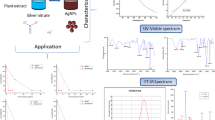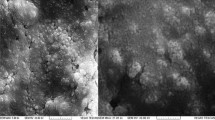Abstract
The high prevalence of infections caused by antibiotic-resistant bacteria has stimulated the development of new therapeutic strategies. Polymeric materials have aroused the interest of many researchers because of their large field of applications. This work aimed to evaluate the synergistic antimicrobial effect of chitosan in association with ceftazidime as well as possible chemical interactions from this combination by FTIR, XRD and TG/DTG curves. Through these analyses, it was possible to conclude that the proposed method was efficient to incorporate the drug with no changes in the fundamental structure of chitosan. In addition, the developed carrier was responsible for increasing the thermal and hydrolytic stability of the drug. The antibacterial activity of chitosan and ceftazidime-modified chitosan was evaluated against Staphylococcus aureus 25,923 and Escherichia coli 25,922 strains, revealing a possible time-dependent drug release.






Similar content being viewed by others
References
Luo Z, Wu Q, Zhang M. The Synergistic antibacterial effects of water soluble n-succinyl-chitosan with ceftriaxone against Escherichia coli. Lett Drug Des Discov. 2012;9:848–52.
Nisar M, Ahmad MUD, Mushtaq MH, Shehzad W, Hussain A, Muhammad J, Nagaraja KV, Goyal SM. Prevalence and antimicrobial resistance patterns of Campylobacter spp. isolated from retail meat in Lahore, Pakistan. Food Control. 2017;80:327–32.
Kadosaki LLI, Sousa SF, Borges JCM. Análise do uso e da resistência bacteriana aos antimicrobianos em nível hospitalar. Rev Bras Farm. 2012;93:128–35.
Mourya VK, Inamdar NN, Tiwari A. Carboxymethyl chitosan and its applications. Adv Mater Lett. 2010;1:11–33.
Silva HSR, Santos KSCR, Ferreira EI. Quitosana: derivados hidrossolúveis, aplicações farmacêuticas e avanços. Quím Nova. 2006;29:776–85.
Osorio LR, Lima IS, Barreto HM, Osajima JA, Da Silva Filho EC. Antibacterial activity of a chitosan derivative obtained in the absence of a solvente. Mater Sci Forum. 2016;869:869–73.
Yalinca Z, Yilmaz E, Taneri B, Bullici FTA. A comparative study on antibacterial activities of chitosan based products and their combinations with gentamicin against S. epidermidis and E. coli. Polym Bull. 2013;70:3407–23.
Goy RC, Morais STB, Assis OBG. Evaluation of the antimicrobial activity of chitosan and its quaternized derivative on E. coli and S. aureus growth. Rev Bras Farmacogn. 2016;26:122–7.
Vinsová J, Vavríková E. Derivatives with antimicrobial, antitumour and antioxidant activities—a Review. Curr Pharm Design. 2011;17:3596–607.
Aranaz I, Harris R, Heras A. Chitosan amphiphilic derivatives. Chemistry and applications. Curr Org Chem. 2010;14:308–30.
Lal S, Arora S, Sharma C. Synthesis, thermal and antimicrobial studies of some Schiff bases of chitosan. J Therm Anal Calorim. 2016;124:909–16.
Singh AV. Biopolymers in drug delivery: a review. Pharmacol online. 2011;1:666–74.
Salama HE, Saad GR, Saba MW. Synthesis, characterization and biological activity of Schiff bases based on chitosan and arylpyrazole moiety. Int J Biol Macromol. 2015;79:996–1003.
Zhong Z, Aotegen B, Xu H, Zhao S. Structure and antimicrobial activities of benzoyl phenyl-thiosemicarbazone-chitosans. Int J Biol Macromol. 2012;50:1169–74.
Orgaz B, Lobete MM, Puga CH, Jose CS. Effectiveness of chitosan against mature biofilms formed by food related bacteria. Int J Mol Sci. 2011;12:817–28.
Costa EM, Silva S, Veiga M, Vicente S, Tavaria FK, Pintado ME. Investigation of chitosan’s antibacterial activity against vancomycin resistant microorganisms and their biofilms. Carbohydr Polym. 2017;15:369–76.
Li XF, Feng XQ, Yang S. A mechanism of antibacterial activity of chitosan against Gram-negative bacteria. Chin J Polym Sci. 2010;31:148–53.
Raafat D, Sahl HG. Chitosan and its antimicrobial potential–A critical literature survey. Microb Biotechnol. 2009;2:186–201.
Liu H, Du Y, Wang X, Sun L. Chitosan kills bacteria through cell membrane damage. Int J Food Microbiol. 2004;95:147–55.
Ahmed AT, Ibrahim SI, Al-Saman A, Mahmoud A, Moussa SH. Production of fungal chitosan from date wastes and its application as a biopreservative for minced meat. Int J Biol Macromol. 2014;69:471–5.
Kong M, Chen XG, Xing K, Park HJ. Antimicrobial properties of chitosan and mode of action: a state of the art review. Int J Food Microbiol. 2010;144:51–63.
Chung YC, Su YP, Chen CC, Jia G, Wang HL, Wu JG, Lin JG. Relationship between antibacterial activity of chitosan and surface characteristics of cell wall. Acta Pharm Sin. 2004;27:932–6.
Helander IM, Nurmiaho-Lassila EL, Ahvenainen R, Rhoades J, Roller S. Chitosan disrupts the barrier properties of the outer membrane of Gram-negative bacteria. Int J Food Microbiol. 2001;71:235–44.
Huang L, Dai T, Xuan Y, Tegos GP, Hamblin MR. Synergistic combination of chitosan acetate with nanoparticle silver as a topical antimicrobial: efficacy against bacterial burn infections. Antimicrob Agents Chemother. 2011;55:3432–8.
Mushtaq S, Khan JA, Rabbani F, Latif U, Arfan M, Yameen MA. Biocompatible biodegradable polymeric antibacterial nanoparticles for enhancing the effects of a third-generation cephalosporin against resistant bacteria. J Med Microbiol. 2017;66:318–27.
Benhabiles MS, Salah R, Lounici H, Drouiche N, Goosen MFA, Mameri N. Antibacterial activity of chitin, chitosan and its oligomers prepared from shrimp shell waste. Food Hydrocoll. 2012;29:48–56.
Chen LC, Chiang WD, Chen WC, Chen HH, Huang YW, Chen WJ, Lin SB. Influence of alanine uptake on Staphylococcus aureus surface charge and its susceptibility to two cationic antibacterial agents, nisin and low molecular weight chitosan. Food Chem. 2012;135:2397–403.
Windholz M. The Merck Index—an encyclopedia of chemicals, drugs and biologicals. 10th ed. Rahway: Merck and Co; 1983.
Misiuk W. Investigation of inclusion complex of HP-γ-cyclodextrin with ceftazidime. J Mol Liq. 2016;224:387–92.
Reiss A, Chifiriuc MC, Amzoiu E, Cioateră N, Dăbuleanu I, Rotaru P. New metal(II) complexes with ceftazidime Schiff base. J Therm Anal Calorim. 2018;131:2073–85.
Bezerra RDS, Morais AIS, Osajima JA, Nunes LCC, da Silva Filho EC. Development of new phosphated cellulose for application as an efficient biomaterial for the incorporation/release of amitriptyline. Int J Biol Macromol. 2016;86:362–75.
Rahmi L, Julinawati S. Preparation of chitosan composite film reinforced with cellulose isolated from oil palm empty fruit bunch and application in cadmium ions removal from aqueous solutions. Carbohydr Polym. 2017;170:226–33.
Jamil B, Habib H, Abbasi S, Nasir H, Rahman A, Rehman A, Bokhari H, Imran M. Cefazolin loaded chitosan nanoparticles to cure multi drug resistant Gram-negative pathogens. Carbohydr Polym. 2016;136:682–91.
Moreno AH, Salgado HRN. Development and validation of the quantitative analysis of ceftazidime in powder for injection by infrared spectroscopy. Phys Chem. 2012;2:6–11.
Dafale NA, Semwal UP, Agarwal PK, Sharma P, Singh GN. Quantification of ceftriaxone sodium in pharmaceutical preparations by a new validated microbiological bioassay. Anal Methods. 2012;4:2490–8.
Kumirska J, Weinhold MX, Thöming J, Stepnowski P. Biomedical activity of chitin/chitosan based materials-influence of physicochemical properties apart from molecular weight and degree of n-acetylation. Polymers. 2011;3:1875–901.
Huang B, Liu M, Zhou C. Chitosan composite hydrogels reinforced with natural clay nanotubes. Carbohydr Polym. 2017;175:689–98.
Abounassif MA, Mian NAA, Mian MS. Analytical profile of ceftazidime. In: Florey K, editor. Analytical profiles of drug substances. San Diego: Academic Press; 1990. p. 95–121.
Zawadzki J, Kaczmrek H. Thermal treatment of chitosan in various conditions. Carbohydr Polym. 2010;80:394–400.
López FA, Mercê ALR, Alguacil FJ, López-Delgado A. A kinetic study on the thermal behaviour of chitosan. J Therm Anal Calorim. 2008;91:633–9.
Kowalonek J. Studies of chitosan/pectin complexes exposed to UV radiation. Int J Biol Macromol. 2017;103:515–52.
Lal S, Arora S, Sharma C. Synthesis, thermal and antimicrobial studies of some Schiff bases of chitosan. J Therm Anal Calorim. 2016;124:909–16.
Tavaria FK, Costa EM, Pina-Vaz I, Carvalho MF, Pintado MM. Chitosan as a dental biomaterial: state of the art. Rev Bras Eng Biomed. 2013;29:110–20.
Pinto NCC, Camposa LM, Evangelista ACS, Lemos ASO, Silva TP, Melo RCN, Lourenço CC, Salvador MJ, Apolônio ACM, Scio E, Fabri RL. Antimicrobial Annona muricata L. (soursop) extract targets the cell membranes of Gram-positive and Gram-negative bacteria. Ind Crops Prod. 2017;107:332–40.
Hayes MV, Orr DC. Mode of action of ceftazidime: affinity for the penicillin-binding proteins of Escherichia coli K12, Pseudomonas aeruginosa and Staphylococcus aureus. J Antimicrob Chemother. 1983;12:119–26.
Li Z, Yang F, Yang R. Synthesis and characterization of chitosan derivatives with dual-antibacterial functional groups. Int J Biol Macromol. 2015;75:378–87.
Acknowledgements
The authors thank Interdisciplinary Laboratory for Advanced Materials-LIMAV of Federal University of Piauí (UFPI) to provide work research conditions, CAPES, CNPQ and FAPEPI for finantial support.
Author information
Authors and Affiliations
Corresponding author
Ethics declarations
Conflicts of interest
The authors declare no conflict of interest.
Rights and permissions
About this article
Cite this article
Osório, L.R., Meneguin, A.B., da Silva, H.B. et al. Evaluation of physico-chemical properties and antimicrobial synergic effect of ceftazidime-modified chitosan. J Therm Anal Calorim 134, 1629–1636 (2018). https://doi.org/10.1007/s10973-018-7332-6
Received:
Accepted:
Published:
Issue Date:
DOI: https://doi.org/10.1007/s10973-018-7332-6




